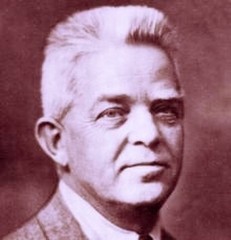|
Back
There Is Nothing Like A Dane New York
Avery Fisher Hall, Lincoln Center
10/01/2014 - & October 2, 3, 2014
Carl Nielsen: Overture to Maskarade – Symphonies No. 5, Opus 50, & No. 6, “Sinfonia semplice”
New York Philharmonic Orchestra, Alan Gilbert (Music Director/Conductor)

A. Gilbert (© New York Philharmonic Orchestra)
Carl Nielsen is amongst the handful of composers of such singularity that one is frustrated in finding antecedents or followers. Yet as Maestro Alan Gilbert has known for many decades now, the Dane’s singularity makes him the most challenging, most colorful, most (seemingly) accessible and (seemingly) enigmatic that he is having an obvious joy in conducting all the symphonies of this composer. He will have recorded all the concertos, the symphonies, and (hopefully) his Helios Overture, one of the most atmospheric tone poems of the last century.
Last night was (in Mr. Gilbert’s words) “wall-to-wall Nielsen”, and it attracted an almost full house, though I doubt they were totally familiar with Nielsen. Some of us wore our “I Heart Nielsen” badges with utmost pride. But the conductor didn’t need a badge. He conducted the Maskarade overture like it was a circus parade. He conducted the very polarized Fifth Symphony with bravado, with stern attention to the percussion and wind solos, and, those countless fugues, with as much transparency as possible. (Those fugues are so complex that they can be unavoidably blurry in performances, unlike late recordings with their focused microphones.)
As for the Sixth Symphony, this was a virtual concerto for orchestra two decades before Bartók. Mr. Gilbert was tempted for the wild exaggeration–and he, thankfully didn’t resist the temptation.

C. Nielsen (© Wikipedia)
Some people still don’t know the music of Carl Nielsen, and trying to describe him is not easy. A story in the program tells of a meeting with the Danish master and Arnold Schoenberg in 1925, where the two of them apparently “chuckled” over which one was most dissonant, most erratic.
The truth is, that while Nielsen may have been a Brahmsian in his first few symphonies, he rode on the cusp from the Late Romantic to the Avant-Garde Apex. And while the dissonances are shown in his music, he, unlike Schoenberg, actually hid them, in the guise of a jester’s motley or a satanic cloak, or in those amazing fugues, or in the most grandiose orchestral color.
Maskarade, then, was not only the title of the first work, it gives symbolic illustration of Nielsen the composer. Except that he doesn’t wear a single mask. The music in the Fifth goes from luscious (if feral menacing) landscapes to wild percussion and snare cadenzas, from flute and clarinet solos to 19th Century Germanic landscape paintings, to the most delicious horn solos.
A Mahler or Bruckner or Rott did the same thing but retained linear continuity. Nielsen keeps the same motives, but he darts off in different directions at the unforeseen times.
Mr. Gilbert certainly has the orchestra to make these variegated moods live. After all, Leonard Bernstein had the same love for Nielsen. But his recordings of the Fifth, while rich and broad, didn’t even attempt when the conductor did last night. Describing this symphony as a Manicheistic war between light and darkness”, Mr. Gilbert made certain that the music rose above the polarity of emotions, he balanced the grand murals with the eccentric solos.
But it was in the Sixth Symphony that Mr. Gilbert gave a performance I could never even imagine. The glockenspiel opening, which was continued throughout the whole work, led to storms, tranquility, The second movement, called Humoreske, is played usually as a debonair parody. Mr. Gilbert decided to make it a full-fledged attack. This wasn’t so much Harlequin as the original diabolic Til Eulenspiegel. For the introduction, he spaced out the different solos–triangles, drum tapes, wind notes– them over the orchestra. After that, Mr. Gilbert rode the orchestra like it was a mad bull, with burlesque trombone glissandi, percussion and flatulent sounds which should never be heard in a proper concert hall.
The third movement was yet another fugue (they were countless), and continued unto a full-fledged last movement which was–in both senses of the word–utterly grand.
The opening Maskarade will be part of the Gilbert-Nielsen recording cycle, but I could frankly watch that performance without the music. Mr. Gilbert, relatively conservative in his movements, here leaped and jumped, cued in everybody, and showed a physical enthusiasm for the composer which–even for the unsuspecting audience–was unavoidably infectious.
Harry Rolnick
|